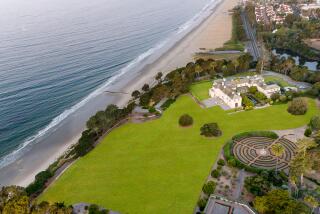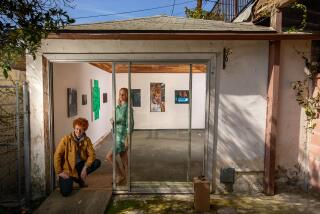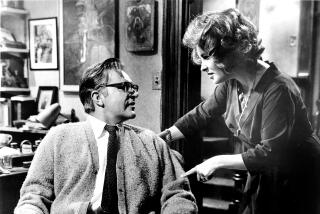In London’s Bloomsbury, the artistic legacy of two strong-willed sisters
- Share via
When I visit London, I usually stay in Bloomsbury, slightly north of Piccadilly Circus and the River Thames. It’s a pleasure to wander among the neighborhood’s stately 19th century row houses and quiet squares, full of landmarks recalling the many intellectuals, artists and writers who once lived there.
Bloomsbury gave its name to a colorful circle of artists and thinkers, including biographer Lytton Strachey, artist Duncan Grant and economist John Maynard Keynes, who started gathering there about 1904 at the home of four orphaned siblings, Thoby, Adrian, Vanessa and Virginia Stephen.
The Bloomsbury Group, as it’s now called, was held together chiefly by the Stephen sisters, better known by their married names: Vanessa Bell and Virginia Woolf. They were strong-willed, vibrant women, and it’s satisfying to summon their spirits when I’m in their London neighborhood.
At a time when most women of their class kept house and went to tea parties, the pair devoted themselves to art. The famous men in the group respected them as equals and rarely took exception when they bucked the sexual status quo. (Virginia went skinny-dipping and cross-dressed. Vanessa lived in a menage a quatre with her husband, Clive; her lover, Duncan Grant; and Grant’s male paramour, David Garnett.) Other women floated in and out of the group as well: artist Dora Carrington, writer Katherine Mansfield and society hostess Lady Ottoline Morrell.
Virginia Woolf especially loved Bloomsbury, which she summoned in “A Room of One’s Own,” her splendid essay on the plight of women. “I must ask you to imagine a room, like many thousands, with a window looking across people’s hats and vans and motorcars to other windows,” she wrote. From this room, perhaps inspired by chambers in her family’s first Bloomsbury home at 46 Gordon Square (now a part of London University, bearing a plaque that identifies it as the former home of Keynes), she tells us that she walked to the British Museum.
The museum makes an excellent first stop for admirers of Bloomsbury women. Looking through the catalog in the domed reading room, Virginia discovered something curious. As she says in “A Room of One’s Own”: “Have you any notion how many books are written about women in the course of one year? Have you any notion how many of them are by men? Are you aware that you are, perhaps, the most discussed animal in the universe?” (The reading room is closed for renovation but will reopen this fall.)
Meanwhile, at the new British Library on the north side of Bloomsbury, you can see the manuscript of Virginia’s 1925 novel, “Mrs. Dalloway,” in a permanent exhibit called “Treasures of the British Library.” “Chapter and Verse,” another exhibit (on display through Oct. 15), includes a recording of Virginia on a BBC radio program.
Her sister, Vanessa, a painter who studied at the Royal Academy of Art (near Piccadilly Circus), took over the house at 46 Gordon Square after her marriage in 1907. The square was also home to Strachey, Carrington and other group members (who had flats at No. 41), and Vanessa’s husband (at No. 50), after the couple started keeping separate quarters. A plaque on the facade of the house at No. 50 Gordon Square commemorates the neighborhood “Bloomsberries.”
Not far away, Virginia and her husband, Leonard, lived from 1924 to 1939 at a site now occupied by the Tavistock Hotel in Tavistock Square. There they ran the Hogarth Press, which published early works by Virginia, Mansfield and T.S. Eliot. Just across busy Tottenham Court Road from Gordon Square, at 33 Fitzroy Square (now the London Foot Hospital and School of Podiatric Medicine), Vanessa and her lover, Grant, established the Omega Workshops, which put impoverished Bloomsbury artists to work creating home furnishings with a modernist flair.
To see Carrington’s paintings and Vanessa’s works, you’ll need to venture out of Bloomsbury to the Courtauld Institute in beautiful Somerset House on the Strand.
For those with a real passion for the Bloomsbury Group, trips to two country homes in eastern Sussex are recommended: Vanessa’s Charleston Farmhouse, where the artist painted, gardened, raised her three children and presided like an all-purpose sprite; and Monk’s House, four miles from Charleston, the rural retreat of the Woolfs.
The Huntington Library, Art Collections and Botanical Gardens in San Marino has brought the Bloomsbury Group closer to home with “The Art of Bloomsbury.” The exhibition (which closes April 30) focuses on the work of Vanessa, Grant and Roger Fry. Among the highlights is Vanessa’s 1912 picture of Virginia in a deck chair.
“Bloomsbury at Home,” by Pamela Todd (Abrams, $27.50), is a rich source of information on the Bloomsbury Group.
Bloomsbury-related places:
The British Museum, Great Russell Street; telephone 011-44-20- 7636-1555, Internet https://www.british-museum.ac.uk.
The British Library, 96 Euston Road; tel. 011-44-20-7412-7332, Internet https://www.bl.uk.
Courtauld Institute of Art, Aldwych end of the Strand close to Waterloo Bridge; tel. 011-44-20-7848-2526, Internet https://www.kcl.ac.uk/inst/courtauld.
Charleston Farmhouse, near Firle, Lewes, East Sussex; tel. 011- 44-1323-811-265, Internet https://www.charleston.org.uk; open April to October.
Monk’s House, Rodmell, Lewes, East Sussex; tel. 011-44-1892-890- 651, Internet https://www.nationaltrust.org.uk; open April to October.
Huntington Library, Art Collections and Botanical Gardens, 1151 Oxford Road, San Marino; tel. (626) 405-2141, Internet https://www .huntington.org.
More to Read
Sign up for The Wild
We’ll help you find the best places to hike, bike and run, as well as the perfect silent spots for meditation and yoga.
You may occasionally receive promotional content from the Los Angeles Times.






